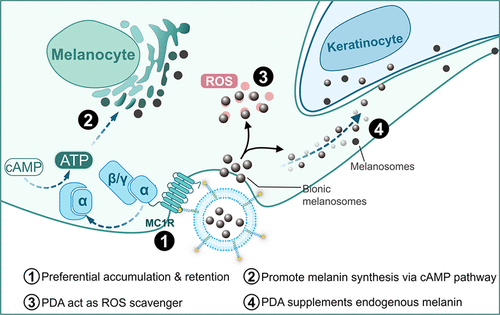Our official English website, www.x-mol.net, welcomes your feedback! (Note: you will need to create a separate account there.)
Biomimetic Melanosomes Promote Orientation-Selective Delivery and Melanocyte Pigmentation in the H2O2-Induced Vitiligo Mouse Model
ACS Nano ( IF 17.1 ) Pub Date : 2021-10-18 , DOI: 10.1021/acsnano.1c05321 Ming-Chen Sun 1 , Xiao-Ling Xu 1 , Yan Du 1 , Xue-Fang Lou 2 , Wei Wang 3 , Yu-Chan You 1 , Di Liu 1 , Fei-Yang Jin 1 , Jing Qi 1 , Min-Xia Zhu 1 , Lu-Wen Zhu 1 , Jun Wang 1 , Yong-Zhong Du 1
ACS Nano ( IF 17.1 ) Pub Date : 2021-10-18 , DOI: 10.1021/acsnano.1c05321 Ming-Chen Sun 1 , Xiao-Ling Xu 1 , Yan Du 1 , Xue-Fang Lou 2 , Wei Wang 3 , Yu-Chan You 1 , Di Liu 1 , Fei-Yang Jin 1 , Jing Qi 1 , Min-Xia Zhu 1 , Lu-Wen Zhu 1 , Jun Wang 1 , Yong-Zhong Du 1
Affiliation

|
Extremely limited drug retention and depigmentation represent the greatest barriers against vitiligo treatment advancement. Here, inspired by biological melanosomes, the primary melanin transporter, we developed biomimetic melanosomes to combat reactive oxygen species (ROS)-mediated melanocyte damage and depigmentation. Briefly, methylprednisolone (MPS) and melanin-mimicking polydopamine (PDA) were encapsulated inside lysine–proline–valine (KPV)-modified deformable liposomes (KPV-Lipos). Owing to their phospholipid bilayer flexibility and the specific affinity for melanocortin 1 receptor (MC1R), KPV-Lipos exhibited 1.43-fold greater skin deposition than traditional liposomes. The binding of KPV and its receptor also contributed to activating the cAMP–tyrosinase (TYR) signaling pathway, improving the endogenous melanin content. In addition, PDA mimicked melanosomes as it effectively increased the exogenous melanin content and scavenged ROS. Meanwhile, MPS inhibited inflammatory cytokine secretion, limiting the depigmented area. Ultimately, the biomimetic melanosomes affected the skin color of mice with H2O2-induced vitiligo. These melanosomes show potential as a universal platform for the self-supply of melanin by self-driven melanin synthesis with exogenous supplementation. Furthermore, this study offers ideas for the production of artificial packed melanosome substitutes for melanocyte-related diseases.
中文翻译:

仿生黑素体在 H2O2 诱导的白斑小鼠模型中促进定向选择性递送和黑素细胞色素沉着
极其有限的药物滞留和色素脱失是白斑病治疗进展的最大障碍。在这里,受主要黑色素转运体生物黑素体的启发,我们开发了仿生黑素体来对抗活性氧 (ROS) 介导的黑素细胞损伤和脱色。简而言之,甲基强的松龙 (MPS) 和黑色素模拟聚多巴胺 (PDA) 被封装在赖氨酸-脯氨酸-缬氨酸 (KPV) 修饰的可变形脂质体 (KPV-Lipos) 中。由于其磷脂双层柔韧性和对黑皮质素 1 受体 (MC1R) 的特异性亲和力,KPV-Lipos 的皮肤沉积比传统脂质体高 1.43 倍。KPV 与其受体的结合也有助于激活 cAMP-酪氨酸酶 (TYR) 信号通路,改善内源性黑色素含量。此外,PDA 模仿黑素体,因为它有效地增加了外源性黑色素含量并清除了 ROS。同时,MPS 抑制炎症细胞因子的分泌,限制脱色区域。最终,仿生黑素体影响了 H 小鼠的肤色2 O 2诱发的白斑病。这些黑色素体显示出作为黑色素自我供给通用平台的潜力,通过自我驱动的黑色素合成和外源性补充。此外,这项研究为生产用于黑素细胞相关疾病的人工包装黑素体替代品提供了思路。
更新日期:2021-11-23
中文翻译:

仿生黑素体在 H2O2 诱导的白斑小鼠模型中促进定向选择性递送和黑素细胞色素沉着
极其有限的药物滞留和色素脱失是白斑病治疗进展的最大障碍。在这里,受主要黑色素转运体生物黑素体的启发,我们开发了仿生黑素体来对抗活性氧 (ROS) 介导的黑素细胞损伤和脱色。简而言之,甲基强的松龙 (MPS) 和黑色素模拟聚多巴胺 (PDA) 被封装在赖氨酸-脯氨酸-缬氨酸 (KPV) 修饰的可变形脂质体 (KPV-Lipos) 中。由于其磷脂双层柔韧性和对黑皮质素 1 受体 (MC1R) 的特异性亲和力,KPV-Lipos 的皮肤沉积比传统脂质体高 1.43 倍。KPV 与其受体的结合也有助于激活 cAMP-酪氨酸酶 (TYR) 信号通路,改善内源性黑色素含量。此外,PDA 模仿黑素体,因为它有效地增加了外源性黑色素含量并清除了 ROS。同时,MPS 抑制炎症细胞因子的分泌,限制脱色区域。最终,仿生黑素体影响了 H 小鼠的肤色2 O 2诱发的白斑病。这些黑色素体显示出作为黑色素自我供给通用平台的潜力,通过自我驱动的黑色素合成和外源性补充。此外,这项研究为生产用于黑素细胞相关疾病的人工包装黑素体替代品提供了思路。



























 京公网安备 11010802027423号
京公网安备 11010802027423号